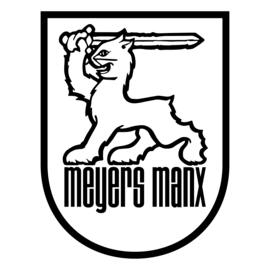Bruce F. Meyers
Engineer
It was at Pismo Beach, Calif. that Bruce first became acquainted with "dune buggies". These "water pumpers" were crude and heavy so Bruce took it upon himself to design a lightweight version that would be fun on the beach or in the wilds of Baja. After modifying a VW Kombi bus with wide rims (called "Little Red Riding Bus"), Bruce used his expertise in boat building to design the first fiberglass-bodied dune buggy, the Meyers Manx.
The first 12 cars produced were all-fiberglass, monocoque bodies that had a steel structural frame within the fiberglass that attached to the VW suspension and running gear (“Old Red” - #1 now resides with Bruce). These cars were expensive (for their time) and redundant in that so much of the VW was thrown away. Bruce redesigned the body to fit on a shortened VW floorpan, which ultimately reduced the price as well. As a result, the Meyers Manx took off. It took the country by storm when magazines like Hot Rod and Car & Driver featured the fiberglass car on their covers. This caused a rash of over 300 orders. Not able to immediately fill these orders, other manufacturers sprang up overnight and ended up producing over 250,000 look-a-likes and near look-a-likes. Eventually over 300 companies, worldwide, copied the Manx in one form or another – even the copiers copied each other. Bruce tried to stop the floodgate of imitations with patent infringement laws but failed to convince the judge that he had produced anything worth a patent. In subsequent years B.F. Meyers & Co. built 5,280 Manx kits, several hundred Manx 2's, about 1,000 Meyers Tow’ds, a couple of hundred Manx SR’s and 75 Resorters - a total of nearly 7,000 kits.
Subject ID: 14201
MoreIt was at Pismo Beach, Calif. that Bruce first became acquainted with "dune buggies". These "water pumpers" were crude and heavy so Bruce took it upon himself to design a lightweight version that would be fun on the beach or in the wilds of Baja. After modifying a VW Kombi bus with wide rims (called "Little Red Riding Bus"), Bruce used his expertise in boat building to design the first fiberglass-bodied dune buggy, the Meyers Manx.
The first 12 cars produced were all-fiberglass, monocoque bodies that had a steel structural frame within the fiberglass that attached to the VW suspension and running gear (“Old Red” - #1 now resides with Bruce). These cars were expensive (for their time) and redundant in that so much of the VW was thrown away. Bruce redesigned the body to fit on a shortened VW floorpan, which ultimately reduced the price as well. As a result, the Meyers Manx took off. It took the country by storm when magazines like Hot Rod and Car & Driver featured the fiberglass car on their covers. This caused a rash of over 300 orders. Not able to immediately fill these orders, other manufacturers sprang up overnight and ended up producing over 250,000 look-a-likes and near look-a-likes. Eventually over 300 companies, worldwide, copied the Manx in one form or another – even the copiers copied each other. Bruce tried to stop the floodgate of imitations with patent infringement laws but failed to convince the judge that he had produced anything worth a patent. In subsequent years B.F. Meyers & Co. built 5,280 Manx kits, several hundred Manx 2's, about 1,000 Meyers Tow’ds, a couple of hundred Manx SR’s and 75 Resorters - a total of nearly 7,000 kits.
Subject ID: 14201
Subject ID: 14201
